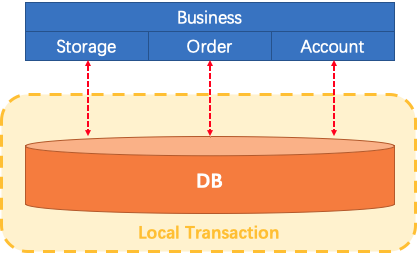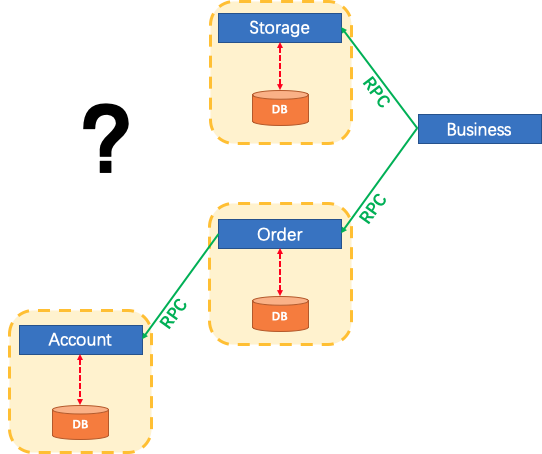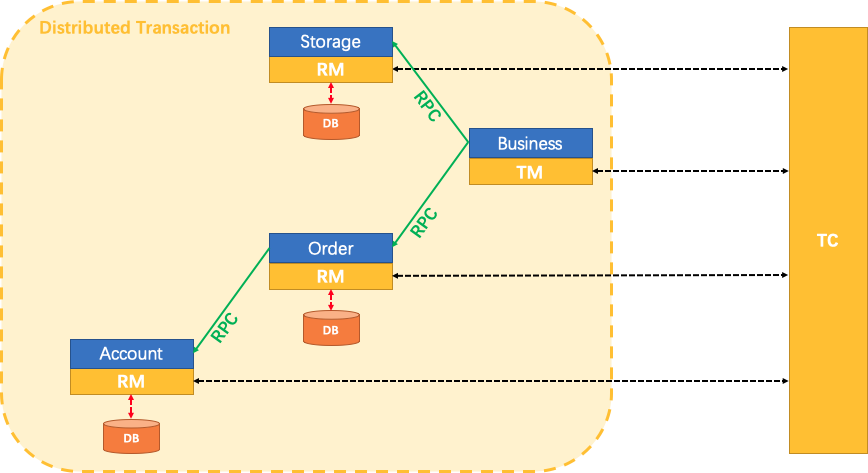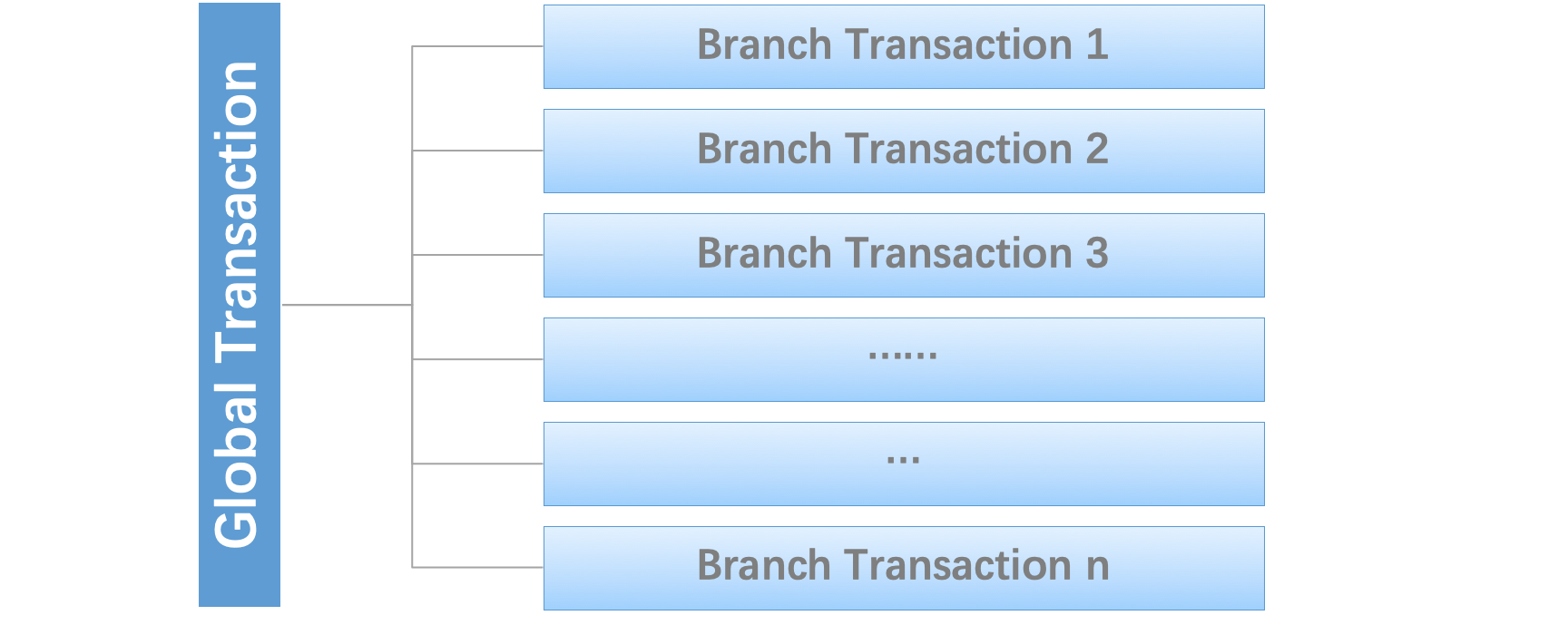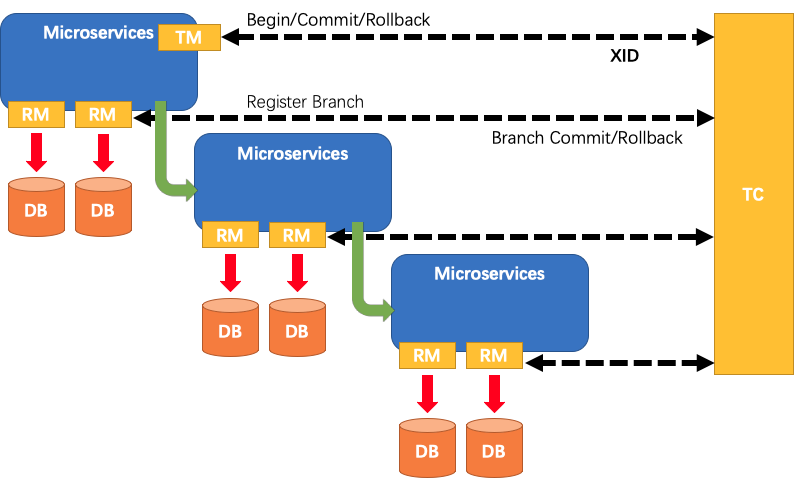A distributed transaction solution with high performance and ease of use for microservices architecture.
Let's imagine a traditional monolithic application. Its business is built up with 3 modules. They use a single local data source.
Naturally, data consistency will be guaranteed by the local transaction.
Things have changed in microservices architecture. The 3 modules mentioned above are designed to be 3 services on top of 3 different data sources (Pattern: Database per service). Data consistency within every single service is naturally guaranteed by the local transaction.
But how about the whole business logic scope?
Seata is just a solution to the problem mentioned above.
Firstly, how to define a Distributed Transaction?
We say, a Distributed Transaction is a Global Transaction which is made up with a batch of Branch Transaction, and normally Branch Transaction is just Local Transaction.
There are 3 basic components in Seata:
- Transaction Coordinator(TC): Maintain status of global and branch transactions, drive the global commit or rollback.
- Transaction Manager(TM): Define the scope of global transaction: begin a global transaction, commit or rollback a global transaction.
- Resource Manager(RM): Manage resources that branch transactions working on, talk to TC for registering branch transactions and reporting status of branch transactions, and drive the branch transaction commit or rollback.
A typical lifecycle of Seata managed distributed transaction:
- TM asks TC to begin a new global transaction. TC generates an XID representing the global transaction.
- XID is propagated through microservices' invoke chain.
- RM register local transaction as a branch of the corresponding global transaction of XID to TC.
- TM asks TC for committing or rollbacking the corresponding global transaction of XID.
- TC drives all branch transactions under the corresponding global transaction of XID to finish branch committing or rollbacking.
For more details about principle and design, please go to Seata wiki page.
- TXC: Taobao Transaction Constructor. Alibaba middleware team start this project since 2014 to meet distributed transaction problem caused by application architecture change from monolithic to microservices.
- GTS: Global Transaction Service. TXC as an Aliyun middleware product with new name GTS was published since 2016.
- Fescar: we start the open source project Fescar based on TXC/GTS since 2019 to work closely with the community in the future.
<fescar.version>0.4.0</fescar.version>
<dependency>
<groupId>com.alibaba.fescar</groupId>
<artifactId>fescar-spring</artifactId>
<version>${fescar.version}</version>
</dependency>
<!--dependency for Apache Dubbo-->
<dependency>
<groupId>com.alibaba.fescar</groupId>
<artifactId>fescar-dubbo</artifactId>
<version>${fescar.version}</version>
</dependency>
<!--dependency for Alibaba Dubbo-->
<dependency>
<groupId>com.alibaba.fescar</groupId>
<artifactId>fescar-dubbo-alibaba</artifactId>
<version>${fescar.version}</version>
</dependency>
You can view the full documentation from the wiki: Seata wiki page.
Please follow the template for reporting any issues.
Contributors are welcomed to join the FEATS project. Please check CONTRIBUTING about how to contribute to this project.
-
Twitter: TBD. Follow along for latest Fescar news on Twitter.
-
Mailing list:
- dev-fescar@googlegroups.com , for dev/user discussion. subscribe, unsubscribe, archive
Dingtalk
- Seata Ecosystem Entry - A GitHub group
seata-groupto gather all Seata relevant projects not appropriate in seata group yet - Seata Samples - Samples for Seata
- Seata Docker - Seata integration with docker
- Seata K8s - Seata integration with k8s
- Awesome Seata - Description of Seata related projects
- Seata Website - Seata official website (In the process of design)
This project exists thanks to all the people who contribute. [Contribute].
Seata is under the Apache 2.0 license. See the LICENSE file for details.



